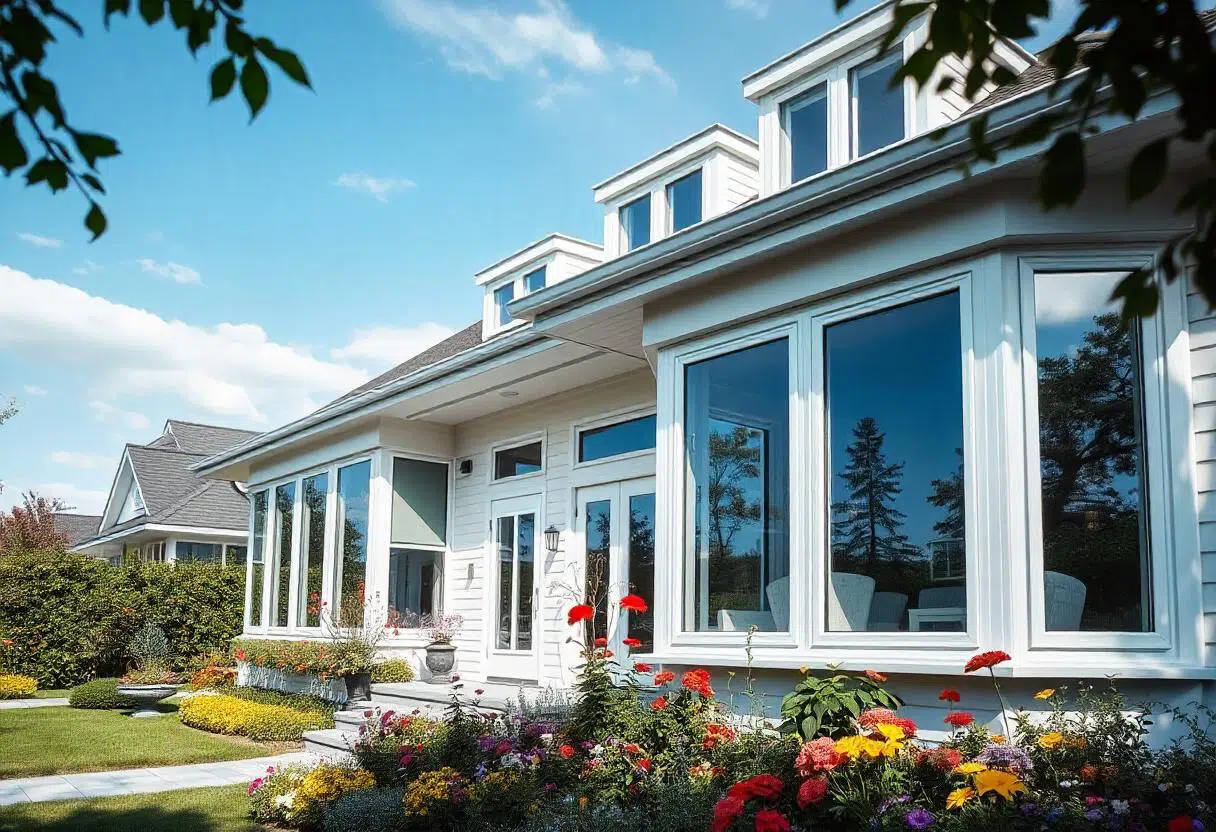Thinking about installing new windows? If your home has drafts, rising energy bills, or condensation between panes, it’s time for a change. This article will walk you through recognizing the signs, the advantages of new windows, and what to consider before making a decision.
Signs It’s Time for New Windows
Homeowners often wonder, “How do I know it’s time to replace my windows?” Early recognition of the signs can prevent higher energy bills and improve home comfort. Cold drafts and moisture between panes signal a need for replacement. Difficulty in opening or closing windows, or a worn-out appearance, indicates they are underperforming.
Underperforming windows can also be suspected if energy bills are high. Drafty windows lead to significant heat loss, increasing heating costs in winter. A spike in energy bills could point to old windows. Condensation between glass panes suggests escaped insulating gas, reducing efficiency.
Replacing windows in a timely manner can prevent further energy loss and discomfort. Addressing issues early leads to a more comfortable home and energy savings. If you notice any signs, it may be time to consider new windows.
Benefits of Installing New Windows
New windows provide benefits that extend beyond aesthetics. Energy savings are a major advantage. Advanced insulation in new windows can significantly lower heating and cooling costs, enhancing home comfort and reducing environmental impact.
New windows can boost your home’s market value, attracting potential buyers who want to own windows. Features like double or triple glazing reduce external noise, leading to a quieter, more peaceful home—even in busy neighborhoods.
Additionally, new windows protect furnishings from UV damage and enhance home aesthetics. With various styles and materials available, you can select windows that complement your home’s design, boosting curb appeal. Whether for energy efficiency, increased home value, or a quieter living space, new windows are a worthwhile investment.
Choosing the Right Type of Windows
With many options available, choosing the right windows can be overwhelming. Each type, from picture to casement windows, has unique benefits and drawbacks. For instance, picture windows are fixed, maximizing the view and offering excellent energy efficiency due to their airtight seal. They suit rooms where ventilation is less important than the view.
Casement windows are hinged at the side and open outward, offering superior ventilation and a tight seal when closed. They are highly energy efficient and ideal for areas needing maximum airflow. Clerestory windows, positioned high on walls, provide natural light while maintaining privacy, perfect for bathrooms or high-ceilinged rooms.
Consider factors like window size, style, energy efficiency, material, maintenance, budget, local climate, and house orientation when selecting windows. Consulting a professional can offer tailored advice on the pros and cons of various window types, helping you make an informed decision.
With the right choice, you can enhance your home’s functionality and aesthetics while boosting energy efficiency.
Energy Efficiency Considerations
Energy efficiency is vital when replacing windows. Low-E coatings on window glass control heat transfer, enhancing energy efficiency significantly. Acting as invisible insulation, these coatings block heat loss in winter and reduce heat gain in summer by up to 50%.
Triple-pane windows, with two chambers filled with inert gases like argon or krypton, provide superior thermal insulation, reducing heat loss more than single or double-glazed units. Investing in energy-efficient windows supports environmental sustainability and results in long-term cost savings.
Maintaining energy performance requires regular tasks like checking and replacing weatherstripping. Curtains and blinds also help minimize winter heat loss and reduce summer solar gain, enhancing overall energy efficiency. Attention to these details can significantly improve your home’s energy performance.
DIY vs. Professional Window Installation
Homeowners often choose between DIY and professional window installation. DIY can save money by eliminating labor costs and offers a sense of accomplishment and new skills. Insert or pocket windows, fitting into existing window frames, are suitable for DIY if the frames are in good condition.
However, DIY installation carries risks. Without proper expertise, you may end up with drafts, leaks, and inefficient windows. Safety is also a concern, especially when working at heights or handling heavy materials. Installation mistakes can lead to window failure, additional costs, and frustration.
Hiring a professional ensures compliance with local building codes and guarantees proper installation. Professionals complete the job efficiently, saving time and ensuring effective window performance. Given the complications, hiring professionals is generally recommended to ensure the job is done right the first time.
Understanding Window Replacement Costs
Understanding window replacement costs is essential for budgeting. Replacing all windows in a typical 1,500 sq/ft home, with 10-15 windows, can range from $15,000 to $20,000, including both windows and labor.
Single window replacement costs range from $450 to $1,400, depending on window type and installation requirements. Factors influencing costs include custom colors, material quality, and glazing type, such as double or triple pane glass. The initial investment is significant, but long-term energy savings and increased home value make it worthwhile.
Investing in high-quality windows ensures durability and performance, reducing future replacement needs. Understanding cost factors and planning accordingly helps you make informed decisions that align with your budget and goals.
The Installation Process
Proper installation and performance require several crucial steps. Before installing new windows, check for rot, water damage, and structural issues in the old windows. After removal, prepare window openings by fixing damage, adding insulation, and sealing gaps.
Windows can be installed from inside or outside the house, depending on project specifics. Installation involves careful alignment, secure fastening, and sealing for proper and efficient setup. Post-installation work may include reworking casing or framing, drywall work, and touch-up painting for a finished look.
Finishing touches like adding trim and caulking complete the installation and ensure a polished appearance. On average, installing a new window takes 2 to 4 hours, while an entire house can take a few days to a week, depending on window number and size. Properly installed windows enhance home aesthetics and ensure optimal performance.
Maintenance Tips for New Windows
Maintaining new windows ensures longevity and efficiency. Vinyl windows are low maintenance, needing regular cleaning with mild soap and water. Avoid abrasive cleaners to prevent damage. Occasional lubrication of moving parts keeps windows operating smoothly.
For casement windows, regularly clean the glass and frames, lubricate hinges and moving parts, and check for wear or damage. Patio doors also need maintenance like cleaning, lubricating moving parts, and checking weatherstripping to remain efficient.
Vinyl windows can last 20 to 40 years or more, but addressing minor damages promptly avoids significant issues. Painting vinyl windows is generally not recommended. Keeping them clean and well-maintained ensures they look and perform their best for years.
How to Choose a Reliable Window Installer
Choosing a reliable window installer is key for a successful window replacements project. Start by getting recommendations from friends and family who had similar work done. This traditional method effectively identifies trustworthy installers. Reviewing past work also provides insights into craftsmanship quality.
Social media pages and online reviews provide insights into an installer’s reputation and service quality, though consider review authenticity. Verify the installer’s certification to ensure they have necessary skills and comply with building regulations. Certification indicates professionalism and expertise.
Professional window installation often includes warranties, providing assurance against potential mistakes and peace of mind. Following these steps helps you find a reliable installer who ensures proper and efficient install windows.
Maximizing Energy Savings
Maximizing energy savings with new windows involves more than just choosing the right products. Sealing gaps between the window and wall is critical for maintaining temperature and improving energy efficiency. Regularly replacing weather stripping maintains insulation and prevents drafts, ensuring optimal window performance.
Energy-efficient windows with features like Low-E coatings and triple glazing significantly reduce heat transfer, keeping your home comfortable year-round. These windows also provide sound insulation, creating a quieter living environment. Investing in the best quality windows will pay off through lower energy bills and increased home value.
Combining high-quality windows with other energy-saving measures, like proper insulation and efficient heating systems, maximizes energy savings. Taking these steps creates a more energy-efficient home, saving money and reducing your environmental footprint.
A True Difference
By investing in high-quality windows and professional installation, you can enjoy a more comfortable, energy-efficient home. Whether you’re looking to save on energy bills, boost your home’s curb appeal, or simply improve your living environment, new windows are a smart and worthwhile investment. Ready to make the change? Contact a reliable window installer today and take the first step towards a better home.


